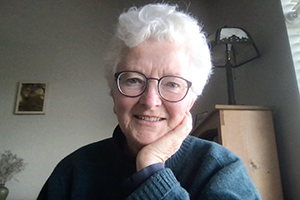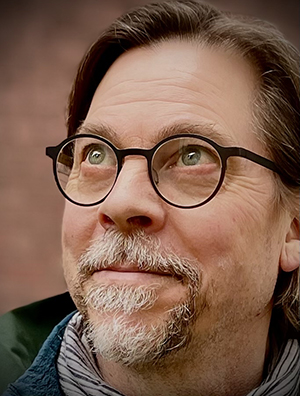To Line Up What's Meaningful: Jay Ruzesky interviews Marlene Cookshaw

Poetry Editorial Board member and Book Reviews Editor Jay Ruzesky talks with Marlene Cookshaw, past Editor of The Malahat Review, whose poems “The Life Separate” and “Mid-Spring” appear in our winter issue #225. They discuss the work of reading poems deeply, examining the roots and rhythms of language, and how metaphor focuses thought.
Born and raised in Lethbridge, Alberta, Marlene studied writing at the University of Victoria and later worked in various capacities, including for several years as the editor of The Malahat Review. Her poems have won a number of awards, among them the Ralph Gustafson Poetry Prize and the Robinson Jeffers Tor House Prize for Poetry. In 2008 she received the Victor Martyn Lynch-Staunton Award for outstanding achievement in mid-career. She has published six collections, five of them with Brick Books, most recently Mowing (2019). She lives in Sidney BC.
In your poem, “The Life Separate,” you (a veteran vegetable farmer!) dig down several layers through metaphor so the gravity of a moment is “drawing in, folding / like the gut or the root of ryegrass or // a colourful Chinese paper chain.” It reminds me a little of Virginia Woolf’s “tunnelling” process in her fiction. It occurs to me that many poets struggle to come up with one good metaphor for something and you have three in this example. Is that the way your mind works—you keep looking for another, better metaphor, or is seeing from more perspectives something you do consciously to add depth to an image?
If I remember correctly this poem was built from a handful of images and phrases that I believed belonged together but was unsure why or how. Writing the poem meant considering and reconsidering each of the elements as accurately and cleanly as I could, allowing them to address and nudge each other, rearranging, banishing whatever threatened to close off further questioning. Metaphor helps me to focus thought, to line up what’s meaningful. Over time I’ve become more patient with what might want to be the subject of the poem.
Two questions about “Mid-Spring”: Because I know you and was around “three decades back” when the action of the latter part of the poem takes place, I know that the job in the poem was working at The Malahat Review (when we were in Sedgewick, I think), and the field was the formerly empty space at UVic on the way to the bookstore. Like you, I absolutely loved crossing that field, especially in evening, because of the way the swallows would chase the bugs I stirred up. The first part of the poem is “Three days ago” and I’m interested to know more about the genesis of the poem. Were you swarmed by swallows and that triggered a memory? If so, it is a vivid memory. How does memory work as a poetic source for you?
I’ve been associated with The Malahat Review for a long time, and I’ve been happy to give my energy to it. I also get things from the relationship (inspiration, for one). You gave a lot of yourself to this magazine for many years and in “Mid-Spring” you (well, the speaker) is “savouring the work I loved.” Can you say something about what you might have received from your work here? What do you miss?
You’re right, “the work I loved” was the work of reading poems deeply, of examining with other writers our interaction with words, their history and effect. I still do that work in the reading of other poets, but rarely now in conversation. I miss that. But I’ve also loved the work of gardening, and years before that the world of sewing and fabrics. I think in part in the writing of “Mid-Spring” I was trying to explore the commonality of those different periods of my life. And wasn’t that a beautiful field? I’m so glad you remember it. It has always struck me as ironic that a building honouring Business and Economics replaced that field as a vessel of knowledge and a way of seeing the world.
I think you are a humble poet, and although I’m quite sure that you want your poems to be read, I’m also sure poetry isn’t something that you do to get attention, nor is it a job. So what is poetry for you? A practice, a discipline, a meditation, a calling, a vocation, or perhaps something else?
I’m not sure, except that it’s important. Language is a tool in every aspect of our lives, but only in poetry do we examine its roots, its rhythms, for its own sake. We tend it; it nourishes us. Practically, personally, writing poems gives shape and meaning to my days, and in the months when something else pushes that lens aside (as, recently, a new dog), I feel its loss. But life sorts itself out.
Your last issue as editor of The Malahat Review was #145 (winter 2003). You’re still writing poetry and (surely) still reading it. Has what you now look for in the poems of others changed since you were selecting poems for the magazine?
I looked then for what I saw as freshness of vision and honesty of voice. I still do, but increasingly I return to the writing of those whose intent seems not to dazzle but to puzzle something out for themselves, so that the nuggets of witness and praise they leave us seem almost incidental. The new poems of John Steffler and Robert Hass got me through the winter, and the old poems of Seamus Heaney and Kate Barnes. And last week I discovered Kathleen Jamie and now want to read everything she’s written. One of the things I love in both reading and writing is how the very individual images and gestures of a poem can create a nexus that invites the unlikely reader in. For instance, you and I know the particular setting of “Mid-Spring,” but anyone who has experienced that open-doorway sensation, that alignment of field and season and active sky, no matter where or when, can step into it.

Jay Ruzesky









